![]()
![]()
![]()
Use LEFT and RIGHT arrow keys to navigate between flashcards;
Use UP and DOWN arrow keys to flip the card;
H to show hint;
A reads text to speech;
36 Cards in this Set
- Front
- Back
|
How does Prokaryotic DNA Replication occurs?
|
• Need to replicate DNA with each cell
division, eg. E. coli • NO nuclear membrane • Generally circular DNA molecule |
|
|
what is the 2 major processes that Eukaryotic DNA replication uses?
|
• Mitosis: produces 2 identical daughter
cells • Meiosis: reduces genetic material content & number of chromosomes by exactly one half – Essential for sexual reproduction |
|
|
what is diploids
|
• Chromosomes exist as homologous
pairs • Types of chromosomes based on position of centromere (distinctive region on chromosome) |
|
|
• Photograph of squash of chromosomes
• Picture taken at metaphase of cell cycle (following DNA synthesis) when sister chromatids are still attached to one anothe |
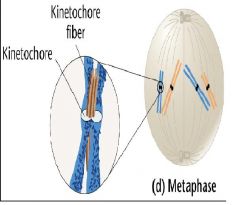
What is Karyotype
|
|
|
what are two way to quantify genetic materials in cell?
|
N vs. C
• N= # of chromosomes in a haploid set – eg, human sperm cell = N = haploid = 23 • 2N = diploid, eg, human liver cell is 2N=46 • C= amount of DNA (weight) in an N nucleus –eg. human C=0.3pg, frog C=3pg • pg = 10-12grams |
|
|
What are the two general portions of cell cycle
|
• 2 general portions
• Interphase (resting phase) • Mitosis: cell division |
|
|
what is the life cycle of mitotsis?
|
-in embryo
-during organ development |
|
|
what is the life cycle of mitosis in adult stage?
|
• Places and times
– Renewable tissue (have stem cells) • Epidermis • GI tract • Mammary glands • Lung • Blood forming tissue • Testis and Ovary |
|
|
Mitosis name the different stage and what happens?
|
• Prophase: centriole migration
• Metaphase: chromosomes lining up • Anaphase: chromosome migration to opposite poles • Telophase: daughter chromosomes at opposite ends, cell divides (cytokinesis) |
|
|
How does N change in cell
cycle? |
2N = 4 example
Telophase 4 0 4 in daughther cells) Anaphase 8 0 8 Metaphase 4 8 8 Prophase 4 8 4 G2 phase 4 8 4 G1 phase 4 0 4 Chromosomes Chromatids Centromeres |
|
|
How does N change in cell
cycle? |
• Human epidermal cell in metaphase =
46 chromosomes, 92 chromatids, 92 centromeres • Frog: 36 chromosomes, 72 chromatids, 72 centromeres |
|
|
what happen during Kinetochores and
Centromeres? |
• Centromeric DNA, specific DNA
(tandem repeated sequences) that allows binding by centromeric proteins • Kinetochore proteins bind to centromeric proteins • Allows attachment to spindle fibers (made of alpha, beta, gamma tubulin), which facilitates transport to poles |
|
|
What G0 activities?
|
• Cell cycle exit
• Non-dividing cells • Cell differentiation |
|
|
what does Stem cells do?
|
• Cell that stay in cell cycle, provide
source of replenishing cells – Eg., epidermis, GI tract, mammary glands, lung, blood forming tissue, testis, ovary |
|
|
what are the Stem cell types?
|
• Adult stem cells: derived from
regenerating tissue types • Pluripotent: can be made to differentiate into more than one cell type |
|
|
what Types of chromosomes based on
position of centromere (distinctive region on chromosome) |

metacentric....
|
|
|
how does the cell cycle look like draw?
|
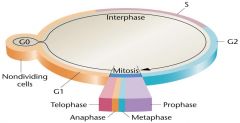
G0,Sphase,G1,mitosis,go
|
|
|
What happens interphase Mitosis?
|
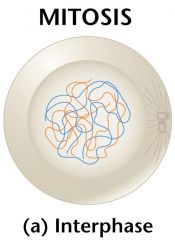
Sphase
synthesis DNA |
|
|
What happens in prophase/
|
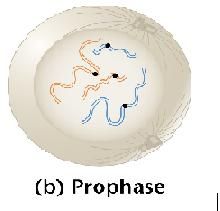
4 Chromosomes
8 Chromatids 4 Centromeres |
|
|
• Checkpoints in cell cycle as decision
process for proceeding to division • Many of these genes are kinases (add phosphates to other proteins) • Phosphorylate cyclins • Cyclin-dependent kinase (Cdk protein) • Different mutations operate at various checkpoints of cell cycle • Eg. p53: recognizes DNA damage at G1/S checkpoint (add to your list of genes) • Different mutations operate at various checkpoints of cell cycle • Eg. p53: recognizes DNA damage at G1/S checkpoint • Targets damaged cell to programmed cell death (apoptosis) pathway • Mutant p53 permits proliferation of damaged cell----> tumor formation • Therefore, p53 is a tumor-suppressor gene (a gene family) |
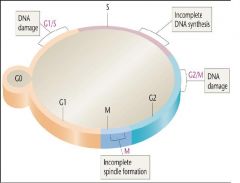
What is Cell division cycle (cdc)
mutations? |
|
|
• KEY difference is Meiosis I: Reduction
division 2N-->N • Meiosis II N--->N |
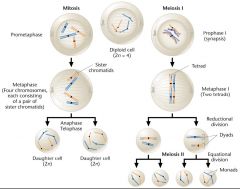
What happens in Meiosis?
|
|
|
What are Meiosis Prophase I Stages?
|
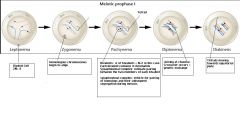
• Leptonema
• Zygonema • Pachynema • Diplonema • Diakinesis |
|
|
Compare cell cycle of mitosis and meiosis?
|
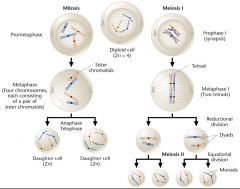
meiosis reduce to one of half monads
mitosis two daughter cell |
|
|
Show the step following meiosis?
|
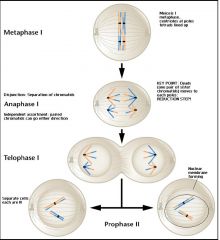
Prophase I: chromatin prsnt intrphase thicken coil into visible chromosome
2. unlike mitosis, member of each homologous pair of chromosomes undergo synapsis 3. crossing over , an exchange process, occurs between homologs. the complexity of these genetic events, this stage of meiosis has further divided into five substages: leptonema,zygonema,pachynema, diplonema end of this, nucleolus and nuclear envolope breaks down,two centromere of each tetrad attach to recently formed spindle fibers,present at equatorial plate cell metaphase I:chromosome have shorten, visible the terminal end of chiasmata of each tetrad, alignment of metaphase plate is random. anaphase I: single centromere holds each pair of sister chromatids together. 2.one half of each tetrad(one pair of sister chromatids called dyad) is pulled toward each pole. separation process is called disjuction of chromosome telephase I: nuclear membraning forms around the dyads, nucleus enters into a short interphase period veryshort period |
|
|
What happens in second Meiotic
Division? |
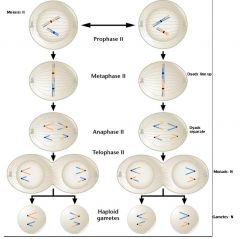
Meiosis II, is essential if each gamete or spore is to receive only one chromatid from each original tetrad.
prophaseII: each dyad is composed of one pair of sister chromatids attach by common cntromere. metapahseII: centromere are positioned on equatorial plate AnaphaseII: sister chromatids of each dyad are pulled to opposite poles telephaseII: reveals one member of each pair pair homologous chromosome present at each pole. each refer to monad. cytokinesis resulting four haploid gametes |
|
|
Compare and contrast Spermatogenesis and Oogenesis?
|
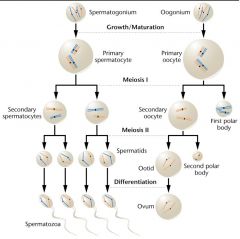
Spermatogenesis:takes place in testes receive equal amount of genetics material cytoplasm,the cycle could be continuous
Oogenesis: female formation of ova 1. equal genetic material but not cytoplasm the two daughter cell 2. cytoplasm concentrate on one of the daughter so that mature ovun is to nourish developing embryo following fertillization, 2. two meiotic division are not continous a. first division of all oocytes begin in the embryonic ovary, arrest in prophase I b. many years later, meiosis resumes in each oocyte just prior to its ovulation, completed after fertilization M II |
|
|
What is Germ cells?
|
• Subset of cells do not become any
particular tissue • Later migrate to the gonad • Then undergo meiosis to form gametes (germ cells) |
|
|
What is the difference between
Germ cells vs. somatic cells? |
• They differ only in their fate
• Meiosis I: 2N ----> N • Fertilization N -----> 2N |
|
|
What does Human germ cells develope into?
|
• Primordial germ cells in yolk sac
• Move to developing gonad |
|
|
Describe Human egg cells?
|
• All oocytes present at birth, resting at
diakinesis stage of cell cycle • 1st follicle cell matures, ~12yrs, oocyte at ovulation goes to metaphase II, lost unless fertilized ______________________________ • Oogonia develop, 1/month • Meiosis results in differentiated ovum (egg) and Polar bodies • If egg fertilized, oocyte no longer arrested in metaphase II: Pregnant |
|
|
Human sperm cell decribe different element that make-Up spermatogenesis?
|
• Stem cell (spermatogonium) population present
• Spermatogonium (2N) • Undergo meiosis to spermatocytes (N) • Further differentiation into sperm • Meiosis results in 4 sperm cells • Continual process |
|

Human ovary with sequence of events from primary ooctye to ovulation name the picture
|
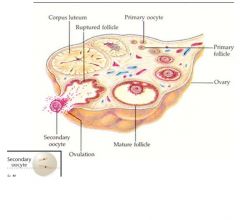
answer
oogenesis: formation of ova, egg occuring in ovaries, female reproductive organ 1.daughter cells resulting from the two meiotic division receive equal amount of genetic material but not equal amount of cytoplasm. 2. primary oocyte: itself derived from oogonium, all most all the cytoplasm is concetrated in one of the two daughter cells. 2. MI,anaphase in oogenesis, the tetrads of the primary oocyte separate,& dyads move toward opposite poles, 2. during telephase I,dyad present at one pole are pinched offf with very little surrounding cytoplasm to form first polar body. 3.secondary oocyte containt most cytoplasm 4.firt polar body may or may not divide again to produce two small haploid cells. 5. mature ovum will be produced from the secondary oocyte during the second meiotic division. 6. secondary oocyte divides agian unequally to producing an ootid and secondary polar body. 7. ootid differentiates into the mature ovum. |
|
|
What occurs in Spermatogenesis
|
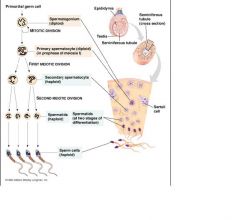
answer
spermatogenesis: in testes, male reproductive organ 1. expanded growth of an undefferentiated diploid gem cell called spermatogonium. 2. cell englarges to become primary spermatocyte, which undergoes first meiotic division. 3. secondary spermatocyte form each containting two haploid of dyad called spermatid 4.spermids go through series of developmental changes spermiogenesis, become highly specialized, motile spermatozoa or sperm. |
|
|
What is Nondisjunction?
|
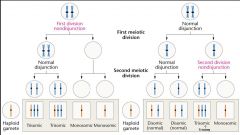
• Separation of chromatids fails to occur
• Can happen in meiosis I or meiosis II • Abnormal gametes produced (monosomic, trisomic) Nondisjunction • Most lethal • Some viable, eg. trisomy 21 • Increase with age |
|
|
What is Autosomal aneuploidy
consequences? |
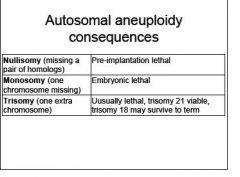
answer
|
|
|
what happens when meiosis fails to achieve normal outcome
how is nonjuction and Trisomy 21, Down Syndrome related? |
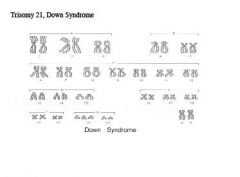
answer
the separation or disjuction of chromatids of tetrad or dyad fail to occur. instead, both members move to the same pole during anaphase which leads to gametes with abnormal # of chromosomes compare to haploid number. error in the system |

